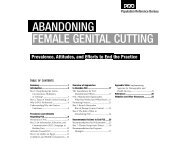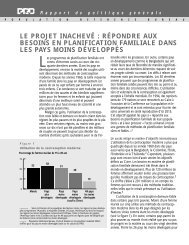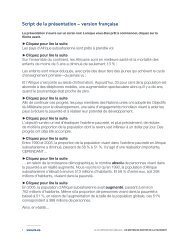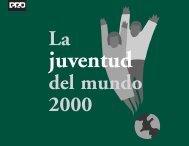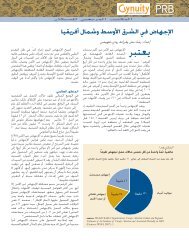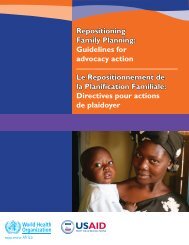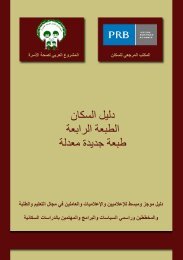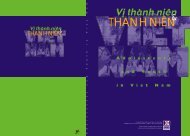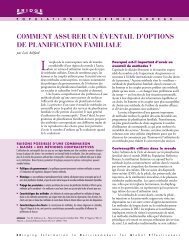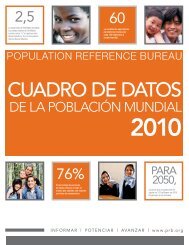Immigration Shaping America - Population Reference Bureau
Immigration Shaping America - Population Reference Bureau
Immigration Shaping America - Population Reference Bureau
Create successful ePaper yourself
Turn your PDF publications into a flip-book with our unique Google optimized e-Paper software.
Table 2<br />
Numerical Limits for Immigrants, Fiscal Year 2001<br />
Preference categories<br />
Numerical limit<br />
Total 675,000<br />
Family-sponsored immigrants—worldwide limit 480,000<br />
Family-sponsored preferences 226,000<br />
First Unmarried sons and daughters of U.S. citizens and their children 23,400<br />
Second Spouses, children, and unmarried sons and daughters of permanent resident aliens 114,200<br />
Third Married sons and daughters of U.S. citizens* 23,400<br />
Fourth Brothers and sisters of U.S. citizens (age 21 or older)* 65,000<br />
Immediate relatives of adult U.S. citizens (spouses, children, and parents)<br />
and children born abroad to alien residents<br />
Unlimited<br />
Employment-based preferences* 140,000<br />
First Priority workers 40,040<br />
Second Professionals with advanced degrees or aliens of exceptional ability 40,040<br />
Third Skilled workers, professionals, needed unskilled workers 40,040<br />
Fourth Special immigrants (ministers, for example) 9,940<br />
Fifth Employment creation (“investors”) 9,940<br />
Diversity immigrants 55,000<br />
*Includes spouses and children.<br />
Notes: The fiscal year runs from Oct. 1, 2000, to Sept. 30, 2001. Immediate relatives may enter without limit, but the number is assumed to be no more than 254,000.<br />
With the 226,000 limit for preference categories, this produces a limit of 480,000 for family-sponsored immigrants. In some categories, visas not used in one year can be<br />
carried over to the next year(s).<br />
Source: <strong>Immigration</strong> and Naturalization Service, 2001 Statistical Yearbook of the <strong>Immigration</strong> and Naturalization Service (2003): A.1-3.<br />
20<br />
of skilled workers was vital to <strong>America</strong>n<br />
competitiveness in global markets, provided<br />
the basis for the <strong>Immigration</strong> Act<br />
of 1990. This law raised the annual<br />
ceiling on immigration and added new<br />
immigration slots, such as the diversity<br />
visas that increased immigration from<br />
Ireland and other countries that had<br />
sent few immigrants in recent times<br />
(see Table 2).<br />
<strong>Immigration</strong> Changes in 1996<br />
In the early 1990s, there was much<br />
debate about immigration, but little<br />
significant new legislation. But pressure<br />
for reform intensified, and 1996<br />
was a watershed year for immigration<br />
legislation, as Congress approved<br />
three major immigration-related laws:<br />
the Antiterrorism and Effective Death<br />
Penalty Act, the Personal Responsibility<br />
and Work Opportunity Reconciliation<br />
Act (PRWORA), and the Illegal<br />
<strong>Immigration</strong> Reform and Immigrant<br />
Responsibility Act (IIRIRA).<br />
These laws were motivated by concern<br />
about terrorism, especially the<br />
role that asylum applicants had in the<br />
1993 World Trade Center bombing;<br />
the desire to find savings to balance<br />
the federal budget and to end perceived<br />
abuses of the U.S. welfare system<br />
by immigrants; and frustration<br />
with continued illegal immigration.<br />
The 1996 antiterrorism law changed<br />
criminal law concerning foreigners,<br />
making it easier to detain without bail<br />
those aliens convicted of crimes committed<br />
in the United States and to<br />
deport them when they have served<br />
their sentences. The same law made<br />
it easier for the INS to exclude foreigners<br />
who arrive at airports without<br />
proper documents and seek asylum in<br />
the United States. Such foreigners can<br />
be subject to “expedited removal” and<br />
barred from legal re-entry if they cannot<br />
make a credible case that they<br />
face persecution at home.<br />
The new welfare law radically<br />
changed the way all low-income residents,<br />
especially new legal immigrants,<br />
receive benefits. Until 1997,<br />
when PRWORA came into force, legal




